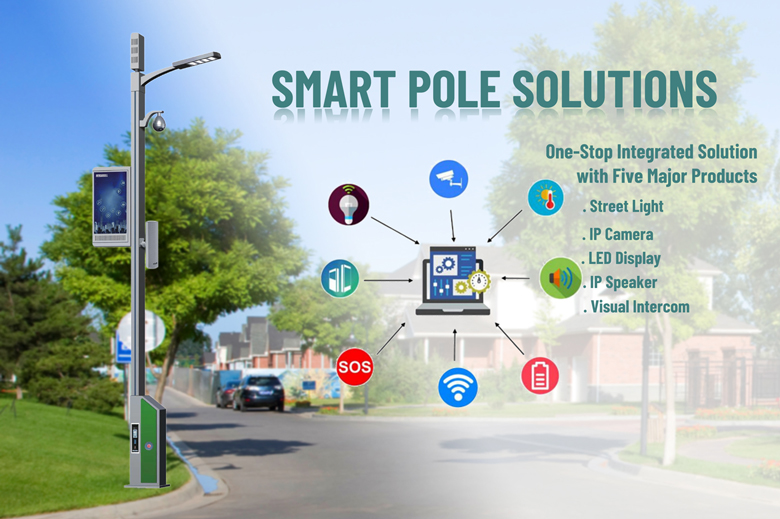

Leave a message

In the construction of smart cities, smart poles, with their features of comprehensive integration, shared usage, smart empowerment, and harmonious development, are becoming an important part of urban infrastructure. This article will provide a detailed introduction to the main features of smart poles and how they provide comprehensive services to the city.

Smart poles are a highly integrated urban infrastructure characterized by the fusion of multiple functions and devices in one. Smart poles integrate LED streetlights, LED displays, IP cameras, environmental / air sensors, SOS emergency intercoms, Wi-Fi access points, IP speakers, mobile chargers, and charging stations among other facilities. This comprehensive integration design not only saves on redundant construction costs but also improves resource efficiency. By integrating the system requirements of multiple vertical fields, such as spatial layout, power supply assurance, communication transmission quality, protocol compatibility, and electromagnetic compatibility, smart poles achieve a comprehensive and efficient solution. This design harnesses technologies such as 5G, IoT, big data, edge computing, and AI, driving the progress of fine-grained urban management.
Smart poles have significant advantages in terms of shared usage. Firstly, they can provide unified pole resources, reducing the demand for pole locations for 4G/5G base stations, cameras, sensors, municipal / traffic facilities, and so on, thus saving a substantial amount of resources. Secondly, the facilities on smart poles share communication and power resources, avoiding the waste of redundant construction. Additionally, by establishing a unified smart pole management platform, data from different systems can be shared, eliminating data barriers and breaking the island effect. This efficient utilization of resources not only reduces construction and maintenance costs but also promotes comprehensive information connectivity in urban management.
Smart poles have "intelligence" at their core, achieving smart functions through the integration of various technologies. Smart poles, as sensing bases, provide various communication interfaces, upgrading traditional pole devices to networked and intelligent devices. With the edge computing capabilities of pole-mounted gateways, remote control via cloud platforms, and AI empowerment, they form an efficient urban information network. This network can collect and analyze vast amounts of data in real-time, providing critical support for urban management decisions. The smart functions of smart poles not only enhance the efficiency of urban governance but also offer more innovative smart services to citizens.
Smart poles contribute to the harmonious unification of urban appearance, ecological environment, and social development. Firstly, in terms of urban appearance, the construction of smart poles enhances the sense of order and landscape quality of street spaces, making pedestrian walkways smooth and continuous. Secondly, in the ecological environment aspect, smart poles reduce energy consumption of municipal facilities and serve as carriers for distributed renewable energy such as solar energy, improving urban pollution prevention and control capabilities. Finally, in social development, smart poles provide services such as traffic signal coordination, congestion warnings, and smart parking, enhancing urban safety and citizens' happiness.
In summary, smart poles, with their characteristics of comprehensive integration, shared usage, smart empowerment, and harmonious development, have become an indispensable essential infrastructure in the construction of smart cities. They not only improve the efficiency of urban management but also enhance the quality of life for citizens, laying a solid foundation for the future development of cities.
 【DSPPA Demo】PAVA8000 EN54 Voice Evacuation SystemNovember 12, 2020Abstract: DSPPA PAVA8000 EN54 Voice Evacuation SystemToday, we are gonna show you a demo about our PAVA8000 EN54 Voice Evacuation System.PAVA8000EN54 Voice Evacuation System can not only support manua...view
【DSPPA Demo】PAVA8000 EN54 Voice Evacuation SystemNovember 12, 2020Abstract: DSPPA PAVA8000 EN54 Voice Evacuation SystemToday, we are gonna show you a demo about our PAVA8000 EN54 Voice Evacuation System.PAVA8000EN54 Voice Evacuation System can not only support manua...view The National Standard Approval Meeting held in BeijingJuly 19, 2019The National Standard Approval Meeting held in BeijingThe approval meeting of the National StandardTechnical standard of public address system engineeringis held in Beijing on July 16, 2019. Xue Chang...view
The National Standard Approval Meeting held in BeijingJuly 19, 2019The National Standard Approval Meeting held in BeijingThe approval meeting of the National StandardTechnical standard of public address system engineeringis held in Beijing on July 16, 2019. Xue Chang...view